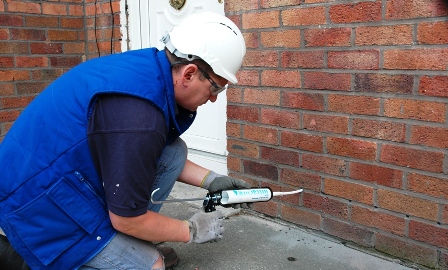Rising damp caused due to the ground water moving upwards is much dangerous for the buildings and our health. Peeling paint and wall paper is the sign of this problem. Likewise harmed skirting boards and damaged floorboards are also the ill effects. Damp results in salt stained plaster or crumbling. Tide marks may also be visible along the walls due to this menace, i.e. the rising damp. Water leaking through the walls may result in penetrating damp that is much horrible. It moves around in horizontal manners and occurs because of structural problems or defective guttering or roofing systems. Damp patches that get darkened during rains are also the signs of penetrating damp.
The building owners may utilize valuable services like damp proofing Chelsea to get rid of the problem. The damp proofing concerns determine the exact causes and sources of damp. Professional damp proofers identify the extent of the problem, its nature and type. Apt damp proofing solutions are suggested. They recommend additional steps if so required for protecting the properties from ill effects of rising damp. Damp Proofing Course is used to check this menace.
Apart from making use of DPC, the following steps may also become necessary to give original finish to the building structures. Re-decoration work may be got accomplished as under:
- The first step is to ensure that plaster is smooth. Re-plastering may not be required if it is intact but bears stains. Now let it get dried up before going ahead with the redecoration work. There should be no salt buildup or salt on the walls due to the damp.
- Anti-Mould Cleaner and Anti-Mould Paint may be used to hide the black spots due to the mould. Likewise Anti-Mould Additive may be used to treat the mould while redecorating. Stain-blocking primer paint may be used to hide the stains.
- Salt neutralizers may be used to treat the fluffy white deposits that are formed because of the buildup of salt on the walls. It may be painted in direct manners on to the walls or by using the plaster enriched with salt neutralizer. It can be added to the plaster mix. Manufacturer’s guidelines must be followed for even use.
- Walls built with non-porous material including granite need adhesives, e.g. Bond Acryl concentrate that sticks the render to the walls. The render may be applied with half inch thickness after dampening the walls. Waterproofing agent like Render proof may be used to facilitate breathable waterproof render for the walls for applying after treating the damp.
- Re-plastering – Many times the plaster loses its strength and gets damaged beyond any repairs. As such it has to be stripped off up to thirty cm deep. A damp meter or the back of the hand may be used to determine this depth of the plaster while stripping it off. Following options are available to avoid future appearance of mould or buildup of salt – (a) Brush the wall down (b) Apply Anti-Mould Cleaner or Salt Neutralizer (c) Fit a mesh membrane prior to re-plastering (d) Add breathable waterproof render to the wall prior to re-plastering.
Damp proofing Chelsea may be of great worth as far as treatment of damp and decoration work is concerned.



